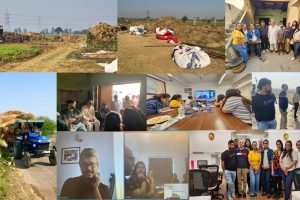Waste management in a city like Bangalore is complicated because of different stakeholder groups that operate at odds with each other. But city residents may have more control over the situation than they think.
Nobody has really mapped the flow of waste end to end. Where does it come from and where does it go? Its tentacles are long and touch multiple points. There is waste coming into the country from abroad and waste going from here to other parts of the world.
Even within a city like Bangalore, the movement of waste is incredibly complicated. For starters, there are three groups of people involved in this effort. There are those at the macro and policy level, who on paper are responsible for creating an infrastructure for waste pickup and disposal. The layer in the middle consists of NGOs and groups who are working towards innovative and effective solutions to the problem. Lastly, there are ragpickers and waste workers on the ground – sorting through and moving mounds of garbage from their points of generation to where they eventually go.
The reason we have a waste management crisis in the city is because that members of this ecosystem operate in silos, instead of examining the problem holistically. In addition, nobody wants to own it – least of all, the citizens of the city.
The problem is compounded by a vast mafia network of contractors who don’t want to see waste being managed better. They are compensated based on the weight of the garbage they transport. Segregation and other sound waste management practices actually eat into their incomes. [Note: Recent news reports suggest that city authorities are trying to move away from the contractor system to something less corruptible].
So, the current stakeholder universe is essentially split into two camps: one that has a vested interest in maintaining the status quo and another that wants the problem to go away but is not willing to do anything about it.
The city’s municipal authority regularly proposes quick fixes or some new technology in order to give the impression that it is working towards solutions. One proposal that often comes up is that of a centralised plant that can process mixed waste and miraculously start generating energy. Such proposals have not worked in the past and are unlikely to work in the future.
This has to do with simple math. It takes time – sometimes two to three days – to transport waste from one end of the city to the other and during this time, it degenerates and starts reeking. A significant portion of compostable waste ends up on our roads. Waste from Indian households is 80% moisture. It has to be first heated to dry it and then heated again to extract energy from it. In essence, we will expend a lot of energy in transporting, heating and processing the waste before we can extract a relatively small amount of low grade energy from it.
The government clearly lacks will but can we blame the authorities entirely when citizens are not pitching in to do their part? Even if municipal agencies worked with missionary zeal, we can’t solve the problem unless each one of us steps up and takes responsibility.
When citizens are educated about their role in the process, it does help to shift the needle significantly. There are currently a number of zero waste communities in the city, for example, and several groups of people who are motivated about making a difference in this area.
But given the complexity of the ecosystem, you may take a step forward only to find yourself being pushed two steps backwards. Currently, there are huge gaps in communication and a lot of contradictory information being disseminated. There is really no channelized communication that addresses the ‘why’ of sound waste management practices, as opposed to the ‘how’.
For example, while the Bangalore municipal authority has made household waste segregation mandatory, it has no easy way of enforcing that mandate. Instead, the aim should be to pitch the vision of zero waste wards to residents. That is not an unrealistic goal given proper segregation and destination-specific disposal of waste. If we are able to engage households in this effort, we can divert 65% of our daily waste – largely compostable wet waste – from landfills. Of the balance, 18% is dry waste which is inherently non-toxic and has resale value. What eventually gets dispatched to landfills are rejects – medical waste, batteries and more – that constitute only 10-20% of what we generate on a daily basis. Consider the impact on the waste management situation if this is done consistently across homes and wards. We can minimise our landfill contribution while simultaneously producing rich compost that rejuvenates the soil.
There are clear benefits – cleaner surroundings, improved overall health – but people need to better understand how their actions are linked to these outcomes. It’s easy to throw our waste into the site next door or dump it into the neighbourhood lake. We indulge in a lot of questionable practices under the cover of anonymity. So, while we need to drive home the twin messages of citizenry and responsibility, we also need some mechanism for exposing and penalising such behaviour.
We can take cues from the elegant and seamless way in which nature disposes of waste. If there is animal excrement on a pavement, it’s immediately covered with organisms that dispose of it efficiently. We need more solutions like these that are simple but highly effective. And we need a chain reaction of sorts for these solutions to take hold and take off.
Waste management in a city like Bangalore is a wicked problem but not an impossible one to tackle. But first, each one of us has to take ownership of the problem. We can no longer dump it into someone else’s bin.
Gayitri Handanahal is the founder of the Waste Impact Trust and Lead Organiser of Reimagine Waste – a series of hackathons to produce innovative solutions to the waste management problem.



